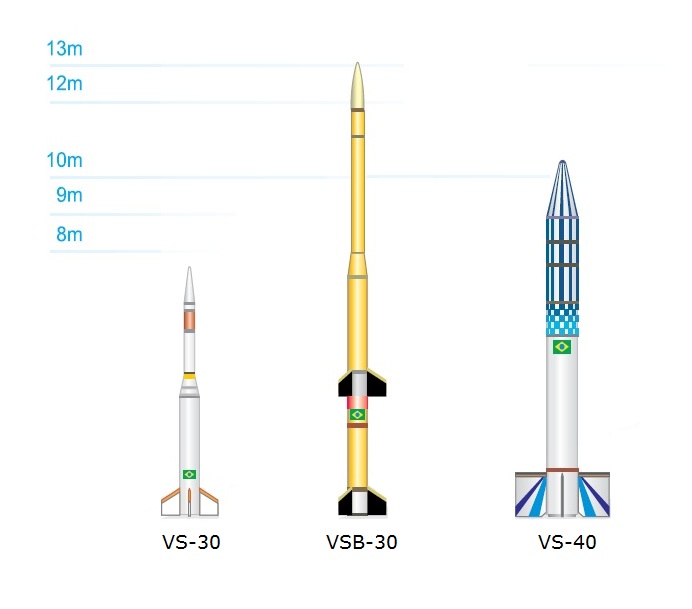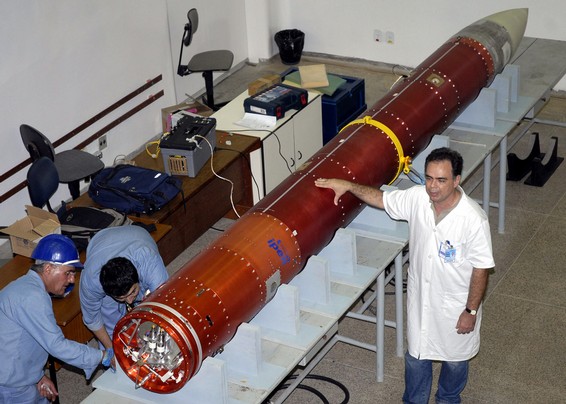|
VS-30
The VS-30 is a Brazilian sounding rocket, derived from the Sonda 3 sounding rocket's first stage.Encyclopedia Astronautica - VS-30 It consists of a single, solid-fuelled stage, and has been launched from Alcântara, , and , , in ... [...More Info...] [...Related Items...] OR: [Wikipedia] [Google] [Baidu] |
Sounding Rocket
A sounding rocket or rocketsonde, sometimes called a research rocket or a suborbital rocket, is an instrument-carrying rocket designed to take measurements and perform scientific experiments during its sub-orbital flight. The rockets are used to launch instruments from 48 to 145 km (30 to 90 miles) above the surface of the Earth, the altitude generally between weather balloons and satellites; the maximum altitude for balloons is about 40 km (25 miles) and the minimum for satellites is approximately 121 km (75 miles). Certain sounding rockets have an apogee between 1,000 and 1,500 km (620 and 930 miles), such as the Black Brant X and XII, which is the maximum apogee of their class. Sounding rockets often use military surplus rocket motors. NASA routinely flies the Terrier Mk 70 boosted Improved Orion, lifting 270–450-kg (600–1,000-pound) payloads into the exoatmospheric region between 97 and 201 km (60 and 125 miles). Etymology The origin of the term ... [...More Info...] [...Related Items...] OR: [Wikipedia] [Google] [Baidu] |
VSB-30
VSB-30 - "''Veículo de Sondagem Booster – 30''" (Booster Sounding Vehicle) or "''Foguete Suborbital VSB-30''" is the designation of a Brazilian sounding rocket, which replaced the Skylark rocket at ''Esrange''. The VSB-30 is based on the VS-30 rocket (S-30 engine) with the addition of a booster stage (S-31 engine). Development started in 2000 in cooperation with DLR. The rocket can carry a payload of 400 kg to an altitude of 270 km. It has a liftoff thrust of 240 kN and a total mass of 2570 kg. It has a diameter of 0.57 m and a length of 12.6 m. VSB-30 was first launched on October 23, 2004, at Alcântara Launch Center. The first launch at ''Esrange'' took place on December 1, 2005. Flights * VSB-30 XV-01 - "Cajuana test" - 2004 October 23 - Apogee: 240 km * VSB-30 V02 -" TEXUS EML-1/TEXUS 42 Microgravity mission" - 2005 December 1 - Apogee: 263 km * VSB-30 V03 -"TEXUS 43 Microgravity mission" - 2006 May 10 - Apogee: 237 km * VSB-30 V04 - ... [...More Info...] [...Related Items...] OR: [Wikipedia] [Google] [Baidu] |
Sounding Rocket
A sounding rocket or rocketsonde, sometimes called a research rocket or a suborbital rocket, is an instrument-carrying rocket designed to take measurements and perform scientific experiments during its sub-orbital flight. The rockets are used to launch instruments from 48 to 145 km (30 to 90 miles) above the surface of the Earth, the altitude generally between weather balloons and satellites; the maximum altitude for balloons is about 40 km (25 miles) and the minimum for satellites is approximately 121 km (75 miles). Certain sounding rockets have an apogee between 1,000 and 1,500 km (620 and 930 miles), such as the Black Brant X and XII, which is the maximum apogee of their class. Sounding rockets often use military surplus rocket motors. NASA routinely flies the Terrier Mk 70 boosted Improved Orion, lifting 270–450-kg (600–1,000-pound) payloads into the exoatmospheric region between 97 and 201 km (60 and 125 miles). Etymology The origin of the term ... [...More Info...] [...Related Items...] OR: [Wikipedia] [Google] [Baidu] |
Barreira Do Inferno Launch Center
The Barreira do Inferno Launch Center ( pt, Centro de Lançamento da Barreira do Inferno; CLBI, ) is a rocket launch base of the Brazilian Space Agency. It was created in 1965, and is located near Ponta Negra beach, near Natal, the capital of the state of Rio Grande do Norte. It has been used for 233 launches from 1965 to 2007, reaching up to 1100 kilometers altitude. It provides tracking support for launches from the Alcântara Launch Center and Guiana Space Centre. Launches The following rockets have been launched from CLBI: * Loki-Dart * * [...More Info...] [...Related Items...] OR: [Wikipedia] [Google] [Baidu] |
Sounding Rockets Of Brazil
Sounding or soundings may refer to: *Sounding (archaeology), a test dig in archaeology *Sounding (Justified), "Sounding" (''Justified''), an episode of the TV series ''Justified'' *Soundings (journal), ''Soundings'' (journal), an academic journal of leftist political thinking *Soundings (radio drama), ''Soundings'' (radio drama), science fiction radio drama series produced from 1985 to 1989 in Ottawa *Soundings (Williams), ''Soundings'' (Williams), 2003 orchestral composition by John Williams *Soundings (Carter), ''Soundings'' (Carter), 2005 orchestral composition by Elliott Carter *Sound (medical instrument), instruments for probing and dilating passages within the body **Urethral sounding, using sounds to increase the inner diameter of the urethra *Depth sounding, a measurement of depth within a body of water *Whale sounding, the act of diving by whales See also *Sound (other) *Sonde (other) * * *Sonar, use of sound propagation to navigate, communicate wit ... [...More Info...] [...Related Items...] OR: [Wikipedia] [Google] [Baidu] |
VS-40
The VS-40 (''Foguete Suborbital VS-40'') is a Brazilian sounding rocket using solid fuel, stabilized aerodynamically, distributed between the first stage S40TM (4,200 kg) engine and the second stage S44M (810 kg) engine. This configuration corresponds to the upper stages of the VLS-1 rocket. Flights * VS-40 PT-01 - "''Operação Santa Maria''" - 1993/04/02 - Qualifying flight for the S44 engine. 760 seconds in micro-gravity. * VS-40 PT-02 - "''Operação Livramento''" - 1998/03/21 - VAP-1 (Fokker) payload. * VS-40M / SHEFEX II - 2012/06/22 - ''SHEFEX ( Sharp Edge Flight Experiment) II'' payload. * VS-40M / V03 - "''Operação São Lourenço''" - 2015/11/13 - '' SARA - Satélite de Reentrada Atmosférica (Atmospheric Reentry Satellite) Suborbital 1'' - Failure (exploded on pad) * VS-40M - in development - HIFiRE 8 * VS-40M - Canceled - ''SARA Suborbital 2'' Characteristics *Length (mm) 6725 *Payload Mass (kg) 500 *Diameter (mm) 1000 *Total takeoff mass (kg) 6,737 * ... [...More Info...] [...Related Items...] OR: [Wikipedia] [Google] [Baidu] |
Brazilian VS Rocket Family Shapes-01
Brazilian commonly refers to: * Something of, from or relating to Brazil * Brazilian Portuguese, the dialect of the Portuguese language used mostly in Brazil * Brazilians, the people (citizens) of Brazil, or of Brazilian descent Brazilian may also refer to: Sports * Brazilian football, see football in Brazil * Brazilian jiu-jitsu, a martial art and combat sport system *''The Brazilians'', a nickname for South African football association club Mamelodi Sundowns F.C. due to their soccer kits which resembles that of the Brazilian national team Other uses * Brazilian waxing, a style of Bikini waxing * Brazilian culture, describing the Culture of Brazil * "The Brazilian", a 1986 instrumental by Genesis * Brazilian barbecue, known as churrasco * Brazilian cuisine See also * ''Brasileiro ''Brasileiro'' is a 1992 album by Sérgio Mendes and other artists including Carlinhos Brown which won the 1993 Grammy Award for Best World Music Album. Track listing # "Fanfarra" (Carlinhos Brown) ... [...More Info...] [...Related Items...] OR: [Wikipedia] [Google] [Baidu] |
HIFiRE
HyShot is a research project of The University of Queensland, Australiabr>Centre for Hypersonics to demonstrate the possibility of supersonic combustion under flight conditions using two scramjet engines, one designed by The University of Queensland and one designed by QinetiQ (formerly the MOD's Defence Evaluation & Research Agency).Michael K. Smart, Neal E. Hass, and Allan Paull. "Flight Data Analysis of the HyShot 2 Scramjet Flight Experiment", AIAA Journal, Vol. 44, No. 10 (2006), pp. 2366-2375. Overview The project has involved the successful launch of one engine designed by The University of Queensland, and one launch of the scramjet designed by the British company QinetiQ. Each combustion unit was launched on the nose of a Terrier- Orion Mk70 sounding rocket on a high ballistic trajectory, reaching altitudes of approximately 330 km. The rocket was rotated to face the ground, and the combustion unit ignited for a period of 6–10 seconds while falling between 35&nbs ... [...More Info...] [...Related Items...] OR: [Wikipedia] [Google] [Baidu] |






